
Often, we find ourselves questioning what a term means in a manual, procedure, or even in conversation. And when we look up these terms via a search engine or in a dictionary, the result we are presented with can be inconclusive or vague. To help ease this pain for Combustion Turbine operators, below is a compilation of many commonly used Combustion/Gas Turbine terms with their definitions that can make operators’ lives a little more convenient.
| Term | Description |
|---|---|
| Air Circut Breaker | A device for completing or interrupting the flow of electricity. The contacts in the circuit breaker are exposed to air. Circuit breakers for 480 V (and below) circuits are typically air circuit breakers. |
| Alternating current (AC) | A current that reverses direction in each electrical cycle. |
Ammeter
A device used to measure electric current.
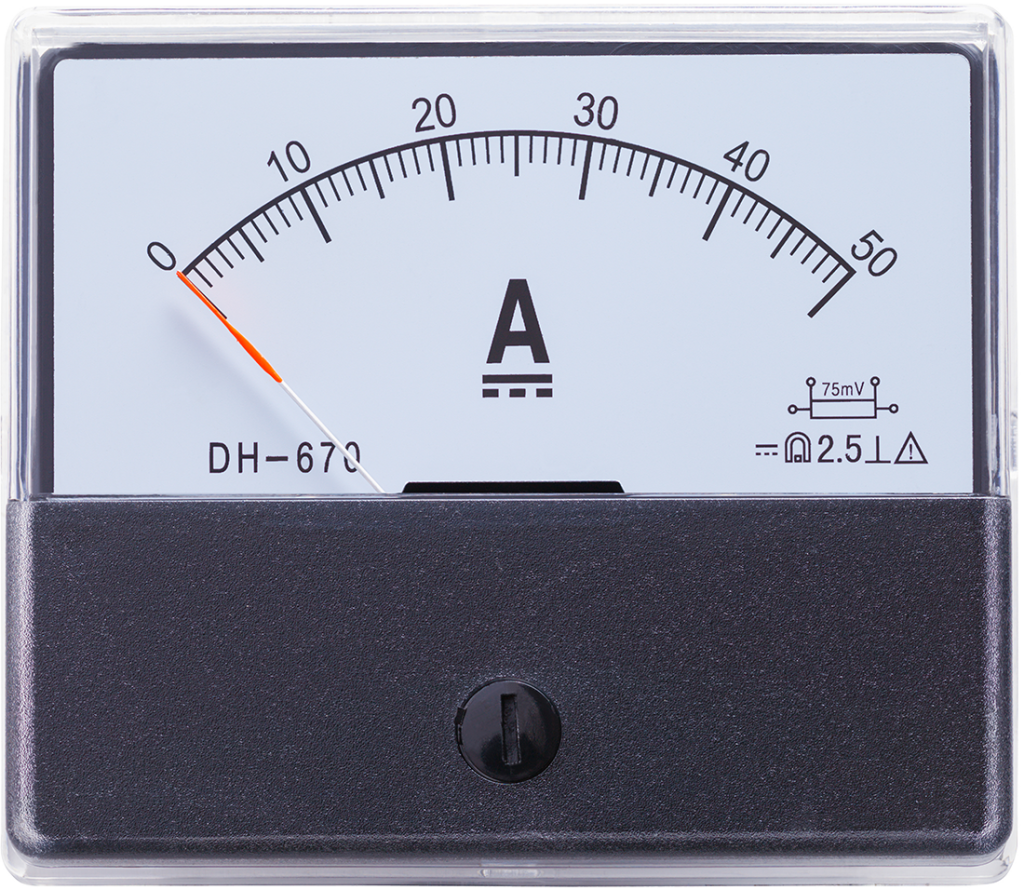
| Ampere (Amp) | A unit of current flow; the current produced by an electro-motive force of 1 volt acting through a resistance of I ohm; 1 coulomb per second. |
| Annunciator | A visual indication, normally a series of words or lights that describe the alarm or operating condition, may be audible and illuminated. |
| Anti-pump device | A relay in the closing circuit of a breaker that will allow only one attempt at a closure while the control switch is held in the close position. |
| Apparent power | Apparent power is proportional to the mathematical product of the volts and amperes of a circuit. This product is generally divided by 1,000 and designated in kilovolt amperes (kVA). It is comprised of both real (watts) and reactive (VAR) power. |
| Arc | The flow of current through air; an arc is drawn when a high voltage circuit breaker is opened/closed or when a conductor gets too close to another conductor. |
| Armature | The part of a generator or motor where voltage is generated or induced. Also, the moving part of a relay. |
| Atmospheric pressure | A unit of pressure equal to the pressure of the air at sea level or approximately 14.7 pounds to the square inch. |
| Auxiliary oil pump | A standby oil pump that will startup automatically due to a decrease in pressure caused by a low discharge pressure from the main pump or if the main pump is driven by the turbine or motor may start on startup or shutdown when the main pump is not running/up to speed. |
| Term | Description |
|---|---|
| Barometric pressure | The pressure of the atmosphere usually expressed in inches of mercury. |
| Basket strainer | A container, installed in a flow path and fitted with mesh or perforated basket, used to remove solid particles from the liquid passing through. |
| Battery charger | A direct current generator, rectifier unit, or any similar electric device used to supply DC power to an operating bus and/or a battery. |
| Breaker (brkr) | The slang expression for an air circuit breaker or oil filled circuit breaker. Used to interrupt or connect current carrying conductors. |
| Burner | A device used to introduce the mixture of fuel and air to the combustion chamber. |
| Bus | An electrical conductor that serves as a common connection for two or more electrical circuits. |
| Bus duct | An enclosed runway for electrical cables or conductors. |
| Term | Description |
|---|---|
| Capacitor | An electrical device consisting of two conducting surfaces separated from each other by an insulating material such as air, oil, paper, glass, mica, or ceramic. It is capable of storing electrical energy and blocking the flow of direct current while allowing alternating and pulsating currents to pass. |
| Cavitation | The rapid formation and collapse of vapor pockets causing air bubbles to form and collapse in a flowing liquid in regions of very low pressure such as the suction of a centrifugal pump. Cavitation is a frequent cause of serious damage to pump impellers. |
| Centigrade | Relating to a scale on a thermometer on which the interval between the freezing point and the boiling point of water is divided into 100 degrees, with 0 degrees representing the freezing point and 100 degrees representing the boiling point; Celsius. |
Circut Breaker
A device used to measure electric current.
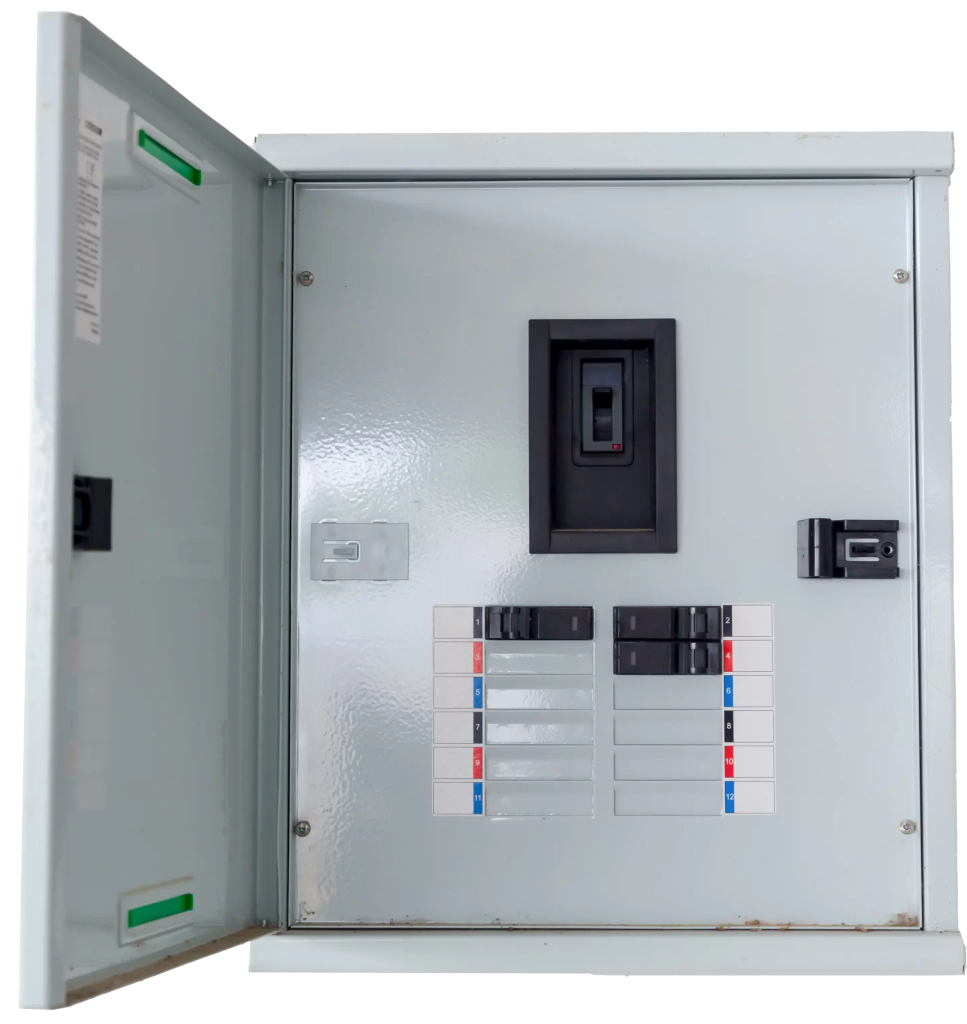
| Closing coil | An electrical coil, located in a circuit breaker, that when energized will close the circuit breaker. |
| Combined cycle | A process that extracts energy from a given heat source via two or more thermodynamic heat cycles, such as combustion turbines and heat recovery steam generator/ turbines. |
| Combustion | The rapid chemical combination of oxygen with the combustible elements of fuel, resulting in the production of heat. |
| Contactor | A device, usually operated by an electric coil, for establishing and interrupting an electric power circuit. A contactor can be a heavy-duty relay used to connect electrical circuits. |
| Contacts | Conducting parts of a switch, contactor, or Circuit breaker that either come together or separate to complete or interrupt a circuit. |
| Control oil | Oil used in a hydraulic system that provides the force to move or position valves, governors, and protective equipment associated with a turbine. |
| Controller | A pneumatic or electrical device that transmits a signal to position a regulating element such as a vane, damper, or valve. |
| Current transformer | A transformer intended for measuring or controlling the current in the circuit. The secondary winding of the transformer is connected to current-responsive devices such as ammeters, watt meters, watt hour meters, relays, trip coils, etc. |
| Cycle (hertz) | In one cycle of alternating electric current, the current goes from zero potential or voltage to a maximum in one direction, back to zero, then to a maximum in the other direction and back to zero again. The number of such complete cycles made each second determines the frequency of the current. In the United States, AC electrical systems operate at 60 cycles per second. |
| Term | Description |
|---|---|
| Data Acquisition System | A computer system used to gather plant data and transfer the information to computer files for use in reviewing and trending plant operations. |
| Delta Connected | A way in which 3-phase electrical systems are connected. A diagram of the phase connections bears a close resemblance to the Greek letter delta. |
| Deluge system | A fire protection system that sprays a high volume of water on potential fire sources, such as transformers, oil reservoirs, or flammable stores. |
| Direct current (DC) | Electrical current that always flows in the same direction from positive to negative potential, as opposed to alternating current (AC), which reverses direction each cycle. |
| Disconnect Switch | A disconnect switch is a device for opening an electrical circuit when there is no voltage on the circuit. A disconnect is used to positively open a circuit for safety or maintenance. |
| Distributed control system (DCS) | An electrical and computer system that has the capability to provide control, indication, and alarm functions. The DCS provides graphical displays and controls of much of the plant equipment, based on operator requests to the DCS. Typically composed of a graphical display on a computer screen. |
| Term | Description |
|---|---|
| Electrohydraulic control system (EHC) | A fluid system, which uses hydraulic oil, used to position valves, pumps, or any component that can be moved by hydraulic oil. Electrical signals are used to vary the oil admitted to or drained from the actuators. |
| Excitation | The power required to create the magnetic field of a generator. |
| Exciter | A DC generator that supplies energy for the field excitation of an AC generator. |
| Term | Description |
|---|---|
| Fahrenheit | Relating to a thermometer on which the interval between the freezing point and boiling point of water is divided into 180 degrees, with 32 degrees representing the freezing point and 212 degrees the boiling point. |
| Fire protection system | The pumps, headers, valves, hoses, nozzles, and electrical devices specifically provided for making people aware of a fire and fighting fires. |
| Flame scanner | A device used to detect flame in the combustion chambers. The indication is transmitted to the Local Operating Station and/or the DCS. |
| Frequency | The number of cycles through which an alternating current passes per second. Frequency in the United States electric utility industry is 60 cycles per second (60 hertz). |
| Term | Description |
|---|---|
| Generator (electric) | A machine that converts mechanical energy to electrical energy. |
| Ground | A conducting connection, whether intentional or accidental, between an electric current or equipment and the earth, or to some conducting body that serves in place of the earth. |
| Term | Description |
|---|---|
| Heat recovery steam generator (HRSG) | An unfired boiler used to transfer heat from the exhaust gases of a combustion turbine to water in order to produce steam. |
| Hertz | A unit of frequency consisting of 1 cycle per second. |
| Term | Description |
|---|---|
| Igniter | A small gas burner nozzle that is ignited by an electric spark. It provides ignition for the main burner. |
| Inlet guide vanes | A set of movable triangular shaped sections, pivoted at a central hub, which controls the amount of air entering a fan or compressor. |
| Inverter | A device for converting direct current into alternating current by mechanical or electronic means. |
Journal Bearing
A radial bearing that uses the hydrodynamic principle of lubrication (i.e. a “wedge” of lubricating oil under pressure) to reduce friction.
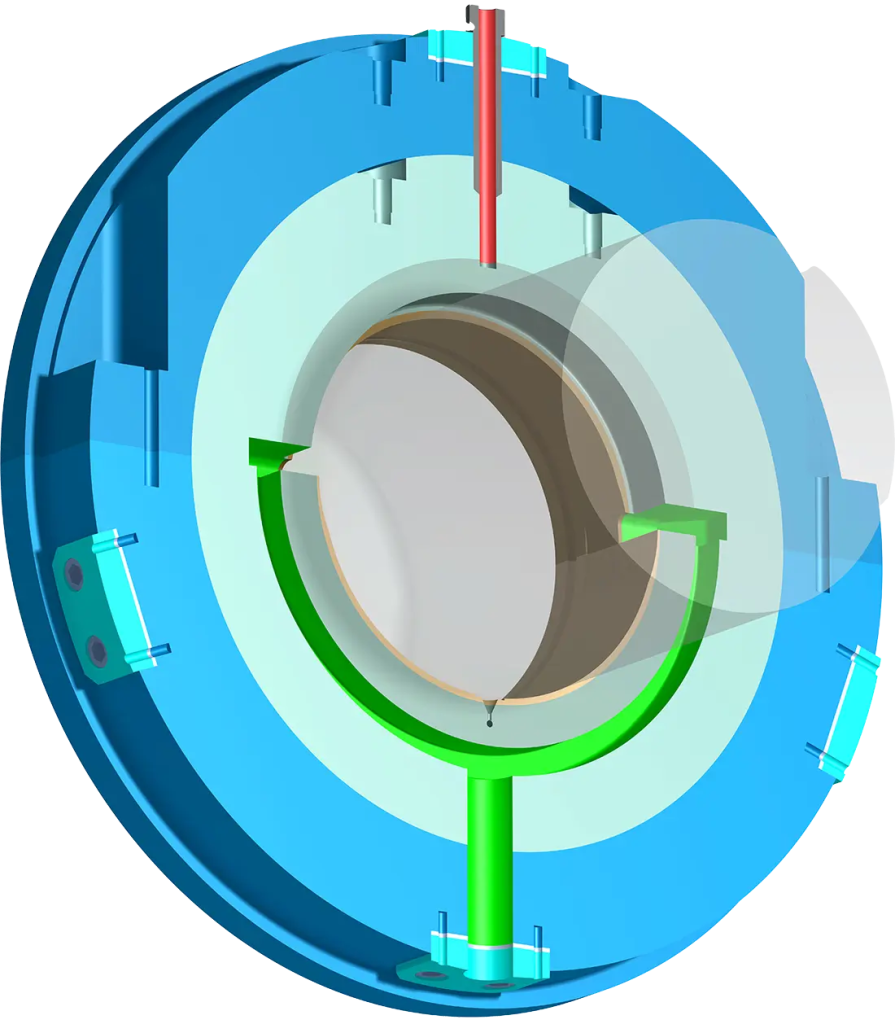
| Term | Description |
|---|---|
| Kilovolt (Kv) | 1,000 volts. |
| Kilovolt-amp (kVA) | 1,000 volt-amps. |
| Kilowatt (kW) | 1,000 watts. |
| Kilowatt-hour (kWh) | One kilowatt of energy expended continuously for 1 hour. |
| Term | Description |
|---|---|
| Labyrinth seal | A seal made up of a set of grooves and ridges that correspond to another set of grooves and ridges on a shaft. For example, on steam turbines the seals prevent steam from escaping along the turbine shaft. The seals promote a torturous path so that the sealed substance has to switch back and forth removing most of the energy from the substance. |
| Load | The amount of electric power delivered or required at any specified point on a system. Load originates primarily at the power-consuming equipment of the customers. |
| Lube oil | Oil used in plant equipment to reduce friction and remove heat from bearings. |
| Term | Description |
|---|---|
| Megawatt (MW) | 1,000,000 watts. |
| Mho | A unit of conductance equal to the reciprocal of the ohm. Liquid conductivity is usually read in micromhos. |
| Milli | A prefix used to indicate one-thousandth. |
| Milliamp | One thousandth of an ampere. |
| Millivolt | One thousandth of a volt. |
| Motor Control Center (MCC) | An electrical distribution point. The motor control center has a circuit breaker for each item of equipment served from the MCC and usually contains step down transformers to lower the voltage for the motors in the MCC. |
| Term | Description |
|---|---|
| Nitrous oxides (NOx) | Products of combustion. The symbol for a collection of nitrogen/oxygen gases such as NO, NO2, NQ, NOB, etc. |
| Term | Description |
|---|---|
| Oil Circuit Breaker (OCB) | A device for completing or interrupting the flow of high voltage electricity. The contacts of the circuit breaker are immersed in oil to suppress and cool the arc formed when the breaker operates. |
| Ohm | The unit of measurement of electrical resistance. It is that resistance through which a difference of potential – or electromotive force – of 1 volt will produce a current of one ampere. |
| One atmosphere (atm) | A unit of pressure equal to the pressure of the atmosphere at sea level, approximately 14.7 pounds per square inch. |
Ohm’s Law
Expresses the relationship between voltage, current, and resistance in a DC Circuit or the relationship between voltage, current, and impedance in an AC circuit. (V=IxR).
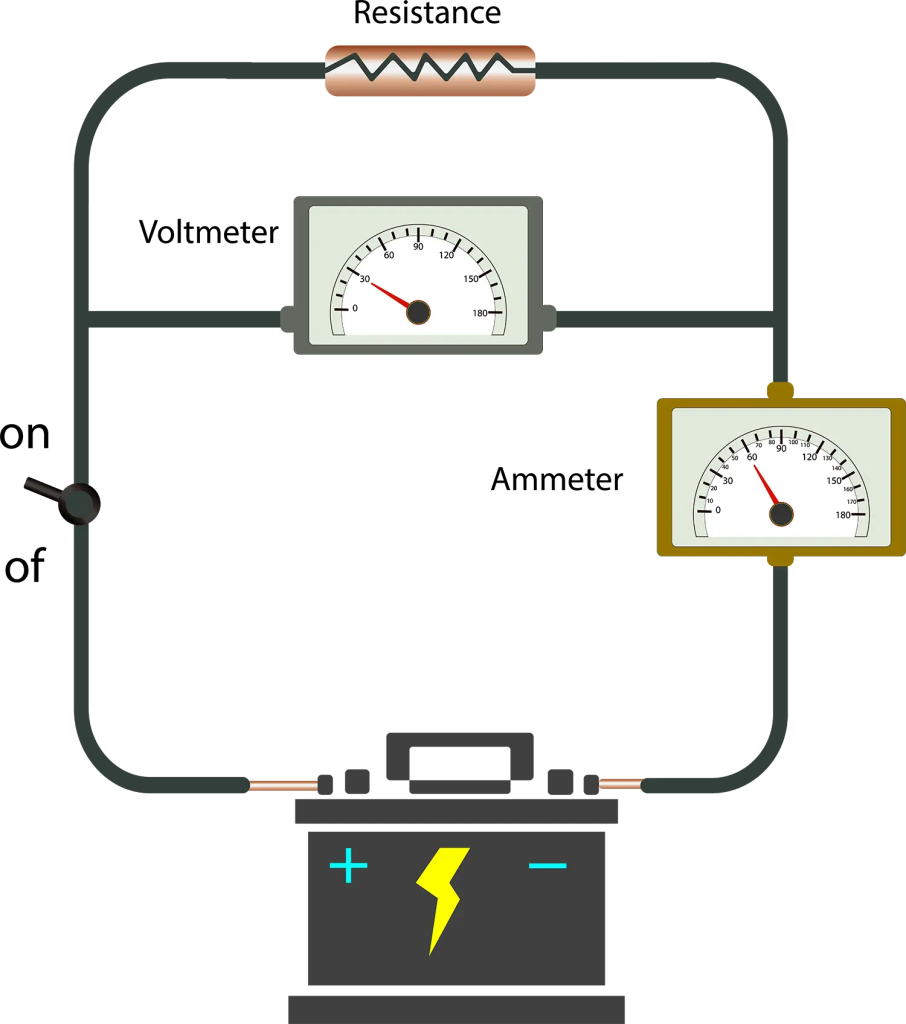
| Term | Description |
|---|---|
| Phase angle | The angular relationship between voltage and current in AC circuits. |
| Potential transformer | A transformer used for measurement or control purposes. Its primary winding is connected in parallel with a circuit, the voltage of which is to be measured or controlled. |
| Power (electrical) | The time rate of generating, transferring, or using electric energy, usually expressed in megawatts. See apparent power, real power, and reactive power. |
| Power factor (pf) | Cosine of the angle between the current phasor and voltage phasor. In simple terms, it is the ratio of Real Power (kW) to Apparent Power (KVa). Power factor is used when specifying total electrical load on an electric motor or the total electrical rating on a generator. |
| Programmable Logic Controller (PLC) | A solid-state controller with a limited programming capability. A PLC is sometimes used to control a system or sub-system within a power plant. |
| Psia | Pressure measured relative to a perfect vacuum is called absolute pressure, psia = psig + atmospheric pressure. |
| Psig | Pressure measured relative to normal atmospheric pressure is called gage pressure, 0 psig is 14.7 psia. |
| Term | Description |
|---|---|
| Rack in | Refers to moving the removable element of a circuit breaker to the position where the primary and secondary disconnecting devices are in full contact. |
| Rack out | Refers to moving the removable element of a circuit breaker to the position where the disconnecting devices are safely separated. |
| Reactive power | The portion of apparent power that does no work. It is commercially measured (in VARs) to most types of magnetic equipment, such as motors. It is supplied by generators or capacitors. |
| Real power | The component of apparent power that represents true work in an AC circuit. It is expressed in megawatts and is equal to the apparent power times the power factor. |
| Relay | An electromagnetic device that is actuated by a variation in conditions of an electrical circuit and in turn causes other devices in the same or related circuits to operate. Used in protective circuits to measure a parameter to protect electrical components. |
| Resistance | The opposition, which a device or material offers to the flow of direct, or alternating current. The opposition results in production of heat in the material carrying the current. Electrical resistance is measured in ohms. |
| Resistor | A device in electrical circuits thatprovides resistance to the flow of electric current. |
| RTD (resistance temperature detector) | A temperature-sensing device that determines temperature by measuring the electrical resistance of a resistor. The resistor is made of a material for which the electrical resistance is a known function of temperature. |
| Term | Description |
|---|---|
| scfm (standard cubic feet per minute) | A measurement of air or gas flow relating to a reference of standard atmospheric pressure (30 inches Hg) at 20 C. |
| Station service | Electric power required for the operation of plant auxiliary equipment such as pumps, fans, etc. |
| Stator | The part or parts of a generator or motor that remains stationary during operation. |
Switchgear
A general term covering switching and disconnect switches. Also assemblies of those devices with control, metering, protective, and regulatory equipment with the associated interconnections and supporting structures.
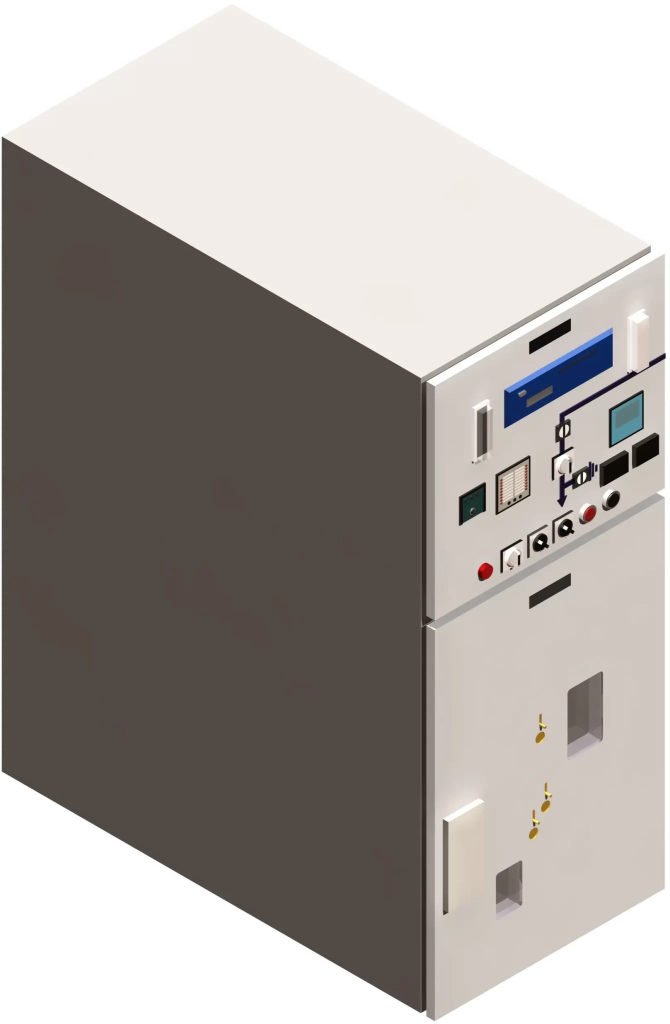
| Switching gloves | Heavy rubber gloves, tested for electrical resistance, used when performing electrical switching, working on energized electrical equipment, or the racking of circuit breakers. |
| Switchyard | The normally enclosed area outside the power building that contains the high voltage buses, circuit breakers, transformers, and disconnects switches. |
| Synchronized | Occurring at the same time. Electrical – two alternating current sources having the same phase angle, voltage, and frequency. |
| Synchroscope | A device used to indicate the relationship of phase angle, voltage, and frequency between two alternating current sources. When a generator is synchronized, the synchroscope must indicate near zero. |
| Term | Description |
|---|---|
| Tap changer | A device located on the windings of a transformer, used to vary the effective number of turns and thus the output voltage. |
| Target | A supplementary device on a relay to indicate that the relay has tripped or is normal. |
| Test position | Refers to a position to which the removable element of a circuit breaker can be positioned for testing. A position on a selector switch for testing. |
| Thermal overload | A relay controlled by the heating effect of motor current. The overload relay will either actuate an alarm, trip the motor, or do both. |
| Thrust bearing | A bearing designed to take loads in the axial direction of a rotating element. The thrust bearing limits the movement of a pump, turbine, or generator rotor. |
| Transformer | An electrical device that transfers electrical energy, by electromagnetic induction, from one or more circuits to one or more other circuits. May be used to step up or step down voltage. Does not affect frequency. |
| Trip coil | An electrical coil utilized for unlatching the trip mechanism of a circuit breaker to open the circuit. |
| Turning gear | An auxiliary device, consisting of an electric motor or hydraulic drive, used to turn the rotating elements of a turbine generator unit at slow and constant speed when the unit is not in service. The turning gear permits the rotor to cool without bowing. |
| Term | Description |
|---|---|
| Unit | All systems required for starting and maintaining output from an electrical generator (i.e., boiler, turbine, generator, and associated auxiliaries). |
| Term | Description |
|---|---|
| Vacuum | Pressure below atmospheric. Expressed in inches of mercury (0 psia is a vacuum of approximately 30 inches of mercury). |
| Vacuum Circuit Breaker (VCB) | An electric circuit breaker, usually 4,160 volts, where the arc between the contacts is drawn and extinguished in a vacuum. |
| VAR | The unit of reactive power. One volt-ampere reactive. |
| Viscosity | The internal resistance of a fluid to flow. Viscosity varies with temperature and is important when selecting lubricating oil. |
| Volt | The electromotive force required to send 1 ampere of current through a resistance of 1 ohm. |
| Voltage regulator | A device or circuit that functions to maintain terminal voltage at a predetermined value, or varies the voltage according to a predetermined plan. |
Voltage Meter
An instrument used to measure voltage.
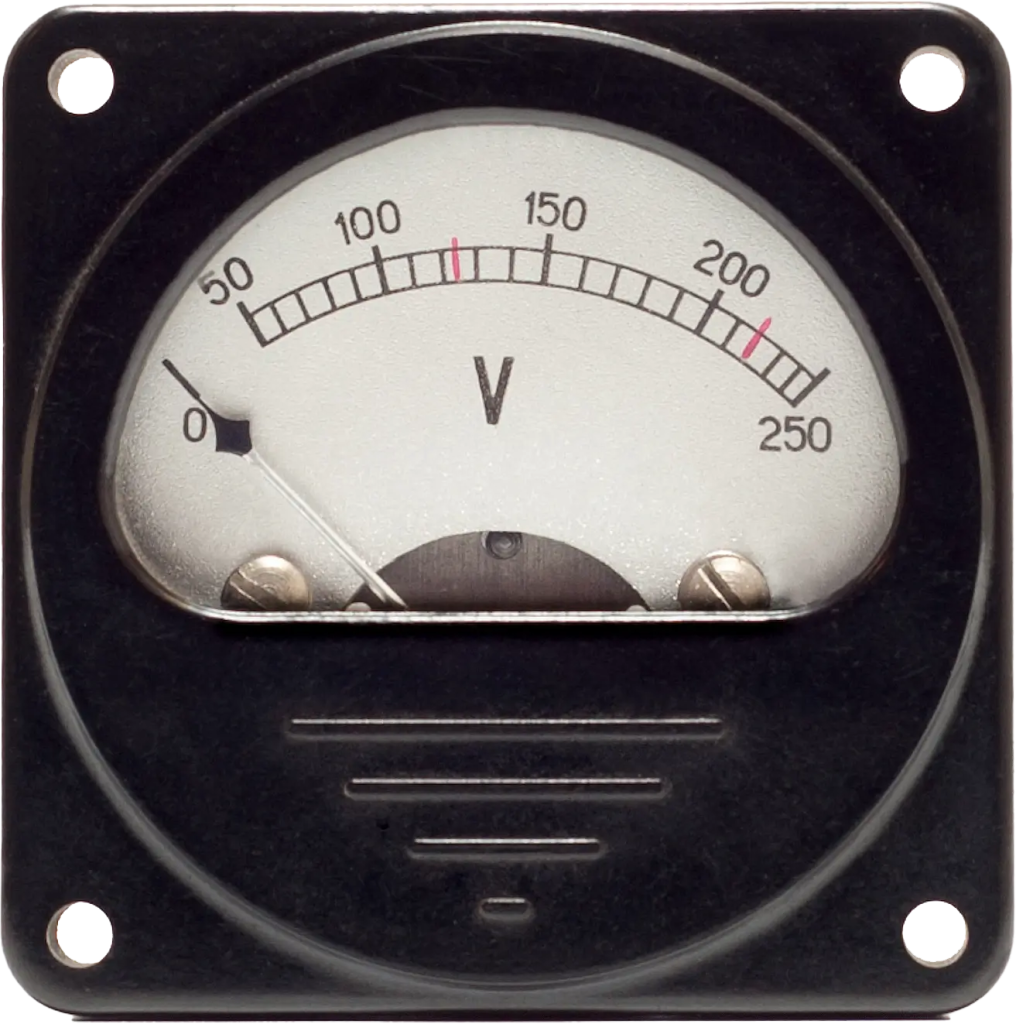
| Term | Description |
|---|---|
| Watt | The unit by which electrical power is measured. |
| Watt-hour meter | A device that measures and registers electrical energy in watt-hours or kilowatt-hours. |
| Windage | A condition caused by turbine blades rotating in a steam-free environment. High temperatures are developed because the means of heat removal is difficult. This condition can occur in the last blade rows of the low-pressure turbine at low load, when rotation is 3,600 rpm with very low steam flow. |
| Work | The movement of an object through distance. The product of force times distance. |